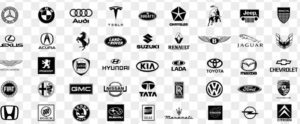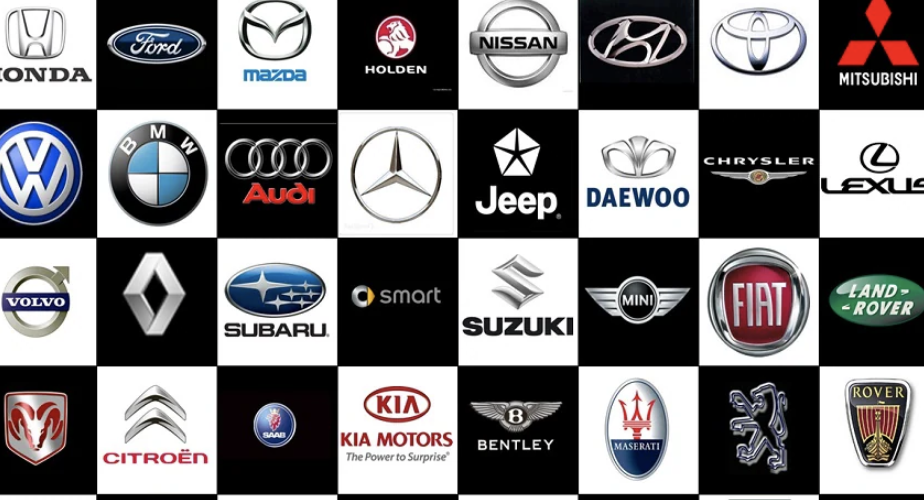Car logos have become an iconic symbol of automotive brands, representing their identity and distinguishing them from their competitors. These logos have evolved over time, reflecting changes in design trends, technology, and consumer preferences. In this article, we will take a deep dive into the evolution of car logos and explore the psychology behind their designs. We will also delve into famous car logos and their meanings, as well as the role of car logos in marketing and brand identity. Finally, we will discuss notable changes in car logos in recent years and speculate on the future of car logo design.

Car Logos
Contents
Evolution of Car Logos Over Time
The history of car logos dates back to the early 20th century when automobile manufacturers started to establish their brands. Initially, these logos were simple and focused on typography, featuring the company’s name in a stylized font. As technology advanced and design aesthetics evolved, car logos began to incorporate graphical elements, such as symbols or emblems, to enhance brand recognition.
In the 1920s, iconic car logos like the Chevrolet bowtie and the Mercedes-Benz three-pointed star emerged, setting the stage for the future of automotive branding. These logos not only represented the brand but also conveyed a sense of prestige and quality. Over the decades, car logos continued to evolve, with companies experimenting with different shapes, colors, and symbols to create a unique visual identity.
The Psychology Behind Car Logos
Car logos are not just random designs; they are carefully crafted to evoke specific emotions and associations in consumers’ minds. The psychology behind car logos lies in the power of visual communication. Colors, shapes, and symbols used in car logos can subconsciously influence consumers’ perceptions of a brand’s values, reliability, and performance.
For example, many luxury car logos incorporate sleek and elegant designs with a focus on symmetry and minimalist aesthetics. These logos aim to convey a sense of sophistication, exclusivity, and high-quality craftsmanship. On the other hand, sports car logos often feature bold and dynamic designs, reflecting speed, power, and adrenaline. By understanding the psychology behind car logos, automotive brands can strategically position themselves in the market and attract their target audience.
Famous Car Logos and Their Meanings
Several car logos have become globally recognized symbols that transcend language and cultural barriers. These logos not only represent the brands but also carry hidden meanings that reflect the company’s history, values, or aspirations. Let’s explore some of the most famous car logos and decipher their meanings.
- The Volkswagen logo, with its iconic “VW” initials enclosed in a circle, symbolizes unity and reliability. The circular shape represents completeness and harmony, while the “VW” letters stand for “Volkswagen” in German, which translates to “people’s car.” This logo embodies the brand’s commitment to producing affordable and reliable vehicles for the masses.
- The BMW logo is a perfect example of a logo with multiple meanings. The circular shape represents movement and the rotation of propeller blades, paying homage to the company’s aviation history. The blue and white colors symbolize the Bavarian state in Germany, where BMW originated. Additionally, some interpret the logo as a nod to the company’s slogan “The Ultimate Driving Machine,” with the blue part resembling the sky and the white part resembling a road.
- The Toyota logo consists of three overlapping ellipses, forming a stylized “T” shape. Each ellipse represents the hearts of the company, the customers, and the progress in technology. The logo’s simplicity and symmetry convey a sense of balance, reliability, and innovation, reflecting Toyota’s commitment to producing high-quality and technologically advanced vehicles.
The Role of Car Logos in Marketing and Brand Identity
Car logos play a crucial role in marketing and brand identity. They are often the first point of contact between consumers and a brand, creating a lasting impression and influencing purchasing decisions. A well-designed car logo can instantly communicate a brand’s values, positioning, and target audience.
One of the primary functions of car logos in marketing is to establish brand recognition and differentiate a brand from its competitors. A memorable and distinctive logo can help a brand stand out in a crowded marketplace and create a sense of trust and familiarity among consumers. Car logos also serve as a visual representation of a brand’s heritage, values, and aspirations, building an emotional connection with consumers.
Furthermore, car logos are utilized in various marketing materials, including advertisements, packaging, and promotional merchandise. Consistent use of the logo across different touchpoints reinforces brand identity and increases brand recall. By incorporating car logos into their marketing strategies, automotive brands can effectively communicate their brand story and create a cohesive brand experience for consumers.
Notable Changes in Car Logos in Recent Years
In recent years, car logos have undergone significant transformations to keep up with changing consumer preferences and design trends. One notable change is the shift towards minimalist and simplified designs. Many car brands have stripped down their logos to their essential elements, removing unnecessary details and focusing on clean lines and bold typography. This minimalist approach reflects a more modern and contemporary aesthetic that resonates with younger generations.
Another trend in car logo design is the incorporation of digital elements. As technology becomes increasingly integrated into vehicles, car logos have started to incorporate digital-inspired designs, such as gradients, 3D effects, and motion-based elements. These dynamic logos reflect the technological advancements in the automotive industry and create a sense of innovation and futurism.
Additionally, car logos have become more adaptive to different platforms and screen sizes. With the rise of digital marketing and online presence, car logos need to be versatile and scalable to ensure optimal visibility and legibility across various mediums, from websites to mobile apps.
The Future of Car Logos
As automotive technology continues to evolve and consumer preferences shift, the future of car logos is likely to witness further transformations. One possible direction is the integration of interactive elements in car logos. With the rise of augmented reality and smart vehicles, car logos could incorporate dynamic features that respond to touch or change based on different driving modes or environmental conditions.
Another aspect to consider is the increasing focus on sustainability and environmental consciousness. As electric and hybrid vehicles become more prevalent, car logos may incorporate elements that symbolize eco-friendliness and clean energy. This could involve the use of green colors or natural motifs to convey a brand’s commitment to sustainability.
Furthermore, personalization and customization could play a significant role in the future of car logos. With advancements in technology, car brands might offer customers the option to customize their logos based on their individual preferences, allowing for a more personalized and unique ownership experience.
Car Logo Design Trends
In recent years, several design trends have emerged in car logo design. These trends shape the visual language of car logos and reflect the evolving tastes and preferences of consumers. Some of the prominent design trends include:
- Minimalist and Simplified Designs: Many car brands have embraced minimalism, opting for clean lines, simple shapes, and bold typography. This design approach creates a modern and timeless aesthetic that appeals to a wide range of consumers.
- Dynamic and Digital-inspired Elements: Car logos are incorporating digital-inspired designs, such as gradients, 3D effects, and motion-based elements. These dynamic logos reflect the technological advancements in the automotive industry and create a sense of innovation and futurism.
- Versatility and Scalability: With the increasing importance of digital marketing and online presence, car logos need to be adaptable and scalable. Logos that can be easily resized and optimized for different platforms ensure consistent brand visibility and recognition.
Conclusion
Car logos have come a long way since their inception, evolving alongside the automotive industry and reflecting changes in design trends and consumer preferences. From simple typography to intricate emblems, these logos have become a powerful tool in marketing and brand identity. Understanding the psychology behind car logos and their meanings allows us to appreciate the thought and creativity that goes into their design. As technology advances and consumer demands shift, car logos will continue to evolve, embracing new design trends and incorporating interactive and personalized elements. The future of car logos holds exciting possibilities, shaping the visual identity of automotive brands for generations to come.
Call to Action: Explore the car logos of your favorite automotive brands and discover the hidden meanings behind their designs. Gain a deeper understanding of the role car logos play in marketing and brand identity.
